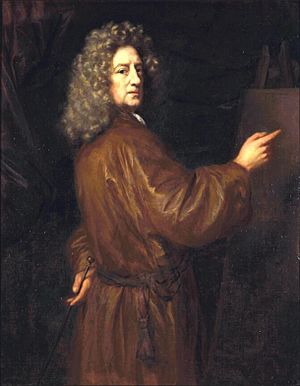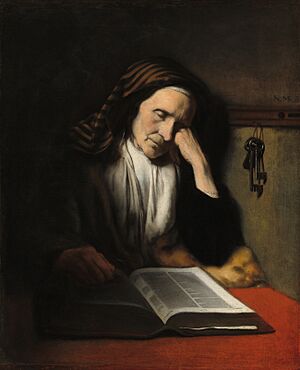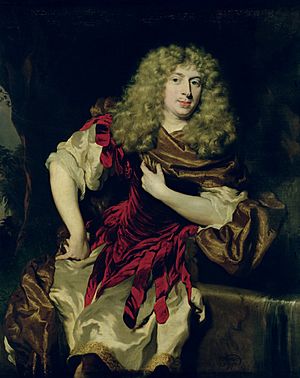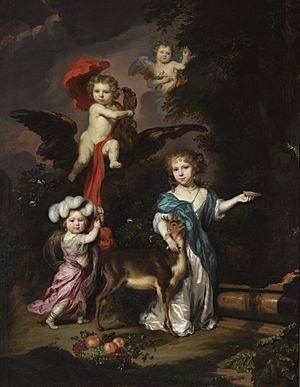Nicolaes Maes facts for kids
Quick facts for kids
Nicolaes Maes
|
|
|---|---|

Self-portrait (c.1685), Dordrechts Museum
|
|
| Born | January 1634 |
| Died | December 1693 (aged 58-59) |
| Nationality | Dutch |
| Education | Rembrandt |
| Known for | genre scenes, portraits, religious compositions |
| Spouse(s) | Adriana Brouwers |
Nicolaes Maes (born January 1634, died December 1693) was a famous Dutch painter. He was known for his paintings of everyday life (called genre scenes), portraits of people, religious pictures, and sometimes still lifes. He learned to paint from the famous artist Rembrandt in Amsterdam.
After his training, Maes went back to his hometown of Dordrecht and worked there for 20 years. Later in his life, he moved back to Amsterdam. There, he became one of the most important portrait painters of his time. Maes helped develop genre painting in the Netherlands. He was also the leading portrait painter in Amsterdam during the late 1600s.
Contents
Life of Nicolaes Maes
Nicolaes Maes was born in Dordrecht, a city in the Netherlands. He was the second son of Gerrit Maes, who was a successful cloth merchant.
Around 1648, Nicolaes went to Amsterdam to study art. He joined the studio of Rembrandt, a very famous painter. Maes stayed with Rembrandt for about five years. By December 1653, he had returned to Dordrecht. He got married to Adriana Brouwers, who was a widow.
A painting from 1653, signed and dated by Maes, shows that he was already working as an independent artist by then.
In the mid-1650s, Maes likely traveled to Antwerp, a city in Belgium. There, he studied the works of Flemish artists like Peter Paul Rubens, Anthony van Dyck, and Jacob Jordaens. It is said that he even visited Jordaens' studio and talked with him about painting.
From the 1660s onwards, Maes mostly painted portraits. He continued to live and work in Dordrecht until 1673. He was quite successful, paying high city taxes. This showed he had a good amount of money. He was also a member of the local civic guard, which was like a city defense group. He even became a lieutenant in it.
Maes moved to Amsterdam in 1673 and lived there until he died. He probably moved because there was a big demand for portrait painters in Amsterdam. Other leading portrait painters had recently passed away. Also, the art market in Dordrecht and other Dutch cities was struggling after the "Rampjaar" (Disaster Year) of 1672. This was a difficult time when French and other armies invaded the Dutch Republic.
Maes hoped his stylish portraits would attract wealthy citizens in Amsterdam. He was right! He became so popular that people felt lucky to have him paint their portraits. Many portraits from the 1670s and 1680s show how successful he was. Some of his students in Dordrecht included his stepson Justus de Gelder and Margaretha van Godewijk.
Even though Maes lived in Amsterdam for a long time, he never became a full citizen. He only registered with the Amsterdam Guild of Saint Luke in 1688. This was after the city asked the Guild for a list of its members. Maes registered as a resident, not a citizen. He was financially successful during his life. When he died, he had a lot of cash and owned five houses.
Maes suffered from gout in his last years. His wife, Adriana Brouwers, was buried in the Oude Kerk, Amsterdam in March 1690. Nicolaes Maes was buried next to her in December 1693.
What Nicolaes Maes Painted
Religious and Mythological Art
In his early years as an independent artist (the early 1650s), Maes painted some religious and mythological scenes. These include Christ Blessing the Children (1652/3) and Vertumnus and Pomona (possibly 1653).
Maes' religious paintings were clearly inspired by his teacher Rembrandt. But Maes also showed his own unique way of telling stories from the Bible. For example, in Dismissal of Hagar and Ishmael (1653), Maes shows Abraham sending away his servant Hagar and their son, Ishmael. The painting shows Hagar's sadness and Ishmael's lonely pose. This makes it one of the most touching versions of this story. Most of Maes' religious paintings were small, except for Christ Blessing the Children, which shows life-sized figures.
Everyday Life Paintings (Genre Scenes)
During his early period, Maes was one of the most creative genre painters in the Dutch Republic. He introduced new topics and invented new ways to show feelings and actions in his paintings. Maes painted many scenes set at people's doorsteps. For example, A young boy receiving alms from an elderly man (1656). He also painted works that praised good parenting. These paintings influenced other Dutch artists like Jan Steen.
Maes used Rembrandt's painting style, like his brushwork and the use of strong light and shadow (called chiaroscuro). He applied this style to everyday scenes, which were very popular with Dutch artists at the time.
His paintings of home interiors often show women doing household chores. Maes gave these scenes a serious and important feeling by using light and shadow, and a limited range of colors. Between 1654 and 1658, he painted many pictures of women spinning, making lace, or mothers with children. These paintings showed the common idea that family life and quiet hard work were very valuable.
An example is The virtuous woman (c.1655). It shows a housewife sewing in a very neat room. An open Bible next to her suggests she is also pure and religious. A small boy at the window might mean the painting is based on a Bible verse about working hard and helping the poor. Maes turned a simple home scene into a picture about dignity and doing what is right, in a truly biblical way.
Maes also created works showing everyday events happening at the front door of a house. These included milkmaids ringing doorbells or getting paid, or boys asking for charity. Maes managed to make these ordinary moments feel important. Another theme he painted in the mid-1650s was older women. He showed them praying before a simple meal, or sleeping while reading a Bible.
Maes made a big change in how artists painted indoor spaces. Instead of showing rooms as flat, three-walled boxes, he painted them as a series of connected rooms. These new ideas about showing indoor space were probably inspired by the new story elements he added to genre painting. These inventions greatly influenced artists from Delft, like Johannes Vermeer and Pieter de Hooch. This was especially true for how they arranged people in indoor spaces. Maes' outdoor genre scenes might also have influenced de Hooch's paintings of courtyards.
Portrait Painting
In his earlier portraits, Maes usually painted people in simple clothes against a dark background. Maes' later style developed in the 1660s. It showed the influence of the Flemish style of portrait painting, which had become popular in the Netherlands. From this time on, Maes used settings and objects often seen in Flemish portraits.
In the 1670s, Maes' style changed again to match the lighter mood of the time. He began to place the people he painted in elegant gardens. These gardens were painted with light colors and loose brushstrokes. These later portraits focused on the people's gestures, poses, clothes, and hairstyles. The way his portraits changed shows the influence of new styles in Flemish and French portrait painting.
Maes painted hundreds of portraits during his later career. He mostly used two standard sizes. One was a small rectangular canvas showing a person from the waist up, inside a painted oval. The other was a larger canvas showing a person from the knees up. These people would often be leaning against something like a column, fountain, or rock. The setting was often a terrace or garden with a sunset sky.
He also painted many group portraits of families or just children. These showed them full-length in a landscape. In the 1670s and early 1680s, he painted several portraits of children dressed as mythological figures. These included Ganymede, Apollo, and Diana. He painted them alone or in family groups. He also painted one group portrait of a guild, called Six Governors of the Amsterdam Surgeons' Guild (1680–81).
Selected Works
- Portrait of Laurence Hyde, Earl of Rochester
- Christ Before Pilate (1649-1650)
- Portrait of Four Children (1657)
- Christ Blessing the Children (1652-1653)
- Portrait of Justus Criex (1666)
 (1655)
(1655)- The Idle Servant (1655)
- The Lacemaker (1649-1650)
- The Lacemaker (1655)
- Old Woman Dozing (1656)
- Portrait of a Woman (1667)
- Portrait of a Woman
- A Woman Spinning (1655)
- Apostle Thomas (1656)
- Woman Plucking a Duck (c.1656)
- Old Woman at Prayer (c.1656)
- Doing the Accounts (1656)
- The Eavesdropper (1657)
- Portrait of Jacob Trip (c.1660)
- Portrait of Margaretha de Geer, Wife of Jacob Trip (c.1660)
- Portrait of Simon van Alphen (c.1680)
- Portrait of William the Third of Orange (after 1677)
See also
 In Spanish: Nicolaes Maes para niños
In Spanish: Nicolaes Maes para niños








